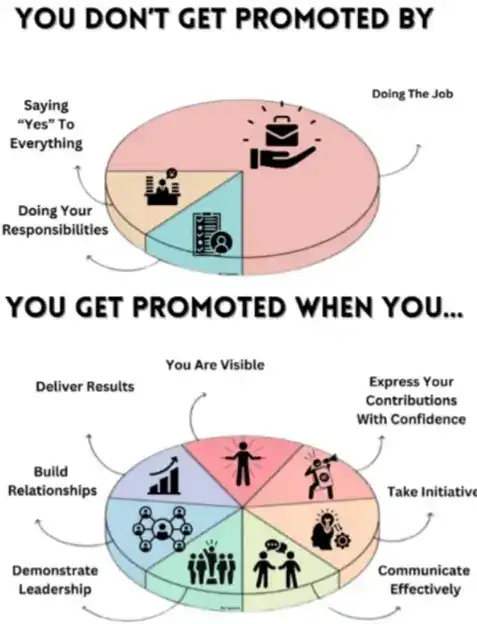You see it all the time: a star performer, a brilliant mind, someone who consistently delivers in their role. When a leadership position opens, they are the obvious choice. Yet, six months in, they’re struggling. Their team is disengaged, their projects are siloed, and the very excellence that defined them hasn’t translated.

Why?
Because we often promote people for the wrong reasons. We promote them for mastering their current job, not for demonstrating their capability for the next one. This simple but profound graphic captures the core of the leadership transition.
Let’s decode this for the C-suite. This isn’t just about career paths; it’s about how you identify and cultivate the future leaders who will drive your company’s growth.
The Trap: Rewarding the “What” Instead of the “How”
The left column represents the qualities of a reliable doer. These are essential, but they are the price of admission, not the ticket to leadership.
- “Doing The Job”: This is tactical execution. The engineer who writes flawless code. The marketer who manages the campaign. They are masters of their domain. But a leader’s job isn’t to do the work; it’s to build a system that enables others to do the work effectively.
- “Saying ‘Yes’ To Everything”: This is the desire to please and a tendency to become a bottleneck. A leader who can’t say “no” to low-priority tasks or misaligned projects will burn out their team and dilute the company’s strategic focus. Agreeableness is not a leadership strategy.
- “Responsibilities”: This is about guarding one’s turf. An employee focused solely on their listed responsibilities is thinking in silos. A leader thinks in systems, understanding how their domain connects to and amplifies others.
Promoting based on these criteria alone is the fastest way to create a team of overwhelmed, tactical managers, not strategic leaders.
The Launchpad: The Three Pillars of Leadership Material
The right column represents the mindset of a strategic leader. This is what you must look for and cultivate.
1. You Deliver Results
This shifts from “I delivered my part” to “I drove the outcome.” A leader takes ownership of a business result, even when it requires influencing parts of the organization they don’t directly control. They are agnostic to whose “responsibility” it is; they are obsessed with what impact is needed. They don’t just complete tasks; they move key metrics that matter to the entire business.
2. You Communicate Value
This is the single most underrated skill in leadership. It’s not about sending status updates. It’s about making the invisible, visible.
- They communicate the value of their team’s work to other departments and to leadership, building bridges and securing resources.
- They translate complex data into a compelling narrative for the board or for customers.
- They advocate for their strategic ideas, persuading others not with authority, but with clarity and insight.
An employee who delivers results but can’t communicate their value is a hidden asset. A leader who can do both is a force multiplier.
3. You Build Influence
While not explicitly stated in the graphic, “You Communicate Value” is the gateway to influence. A leader gets things done through people they don’t directly manage. They build networks. They resolve cross-functional disputes. They inspire action through trust and persuasion, not through mandates. This is the true test of leadership readiness.
The CEO’s Role: Cultivating the Right Garden
As the top leader, your job is to stop promoting people for being excellent at the job they have and start identifying those who are already acting like the leader they could be.
Start asking different questions:
- Don’t ask: “Is she hitting all her goals?” Ask: “Is she solving problems I didn’t know we had?”
- Don’t ask: “Is he a reliable team player?” Ask: “Is he elevating the performance of everyone around him?”
- Don’t ask: “Does she know her domain?” Ask: “Does she understand how her domain impacts our P&L?”
By shifting your focus, you don’t just fill roles—you build a leadership bench capable of carrying your vision forward. You stop rewarding effort and start championing impact.

